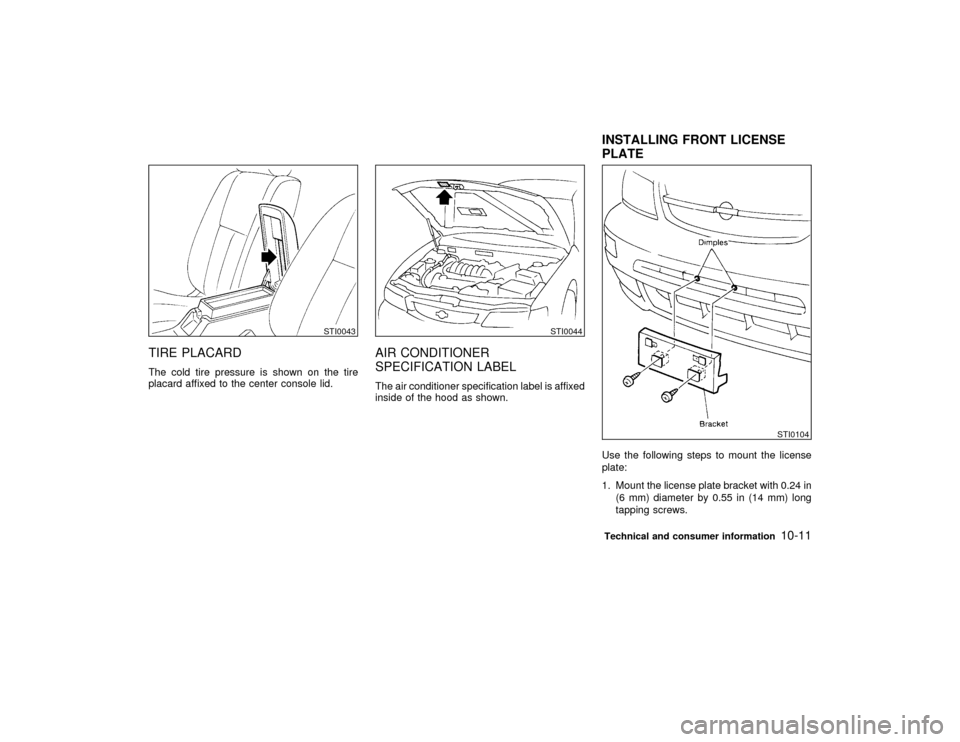1998 NISSAN MAXIMA center console
[x] Cancel search: center consolePage 63 of 231

The front seats are warmed by built-in heaters.
The switches located on the center console
can be operated independently of each other.
1. Start the engine.The battery could run down if the seat
heater is operated while the engine is
not running.
2. Select heat range.
IFor low heat, press the top of the switch.
IFor high heat, press the bottom of the
switch.
IFor no heat, the switch has a center OFF
position between low and high.
The indicator light in the switch will illumi-
nate when low or high is selected.
The heater is controlled by a thermostat,
automatically turning the heater on and off.
The indicator light will remain on as long as
the switch is on.
3. When the vehicle's interior is warmed, or
before you leave the vehicle, be sure to turn
the switch off.Do not use the seat heater for extended
periods or when no one is using the
seat.
IDo not put anything on the seat which
insulates heat, such as a blanket,
cushion, seat cover, etc. Otherwise,
the seat may become overheated.
IDo not place anything hard or heavyon the seat or pierce it with a pin or
similar object. This may result in
damage to the heater.
IAny liquid spilled on the heated seat
should be removed immediately with
a dry cloth.
IWhen cleaning the seat, never use
benzine, thinner, or any similar mate-
rials.
IIf any abnormalities are found or the
heated seat does not operate, turn
the switch off and have the system
checked by your NISSAN dealer.
SIC0693
HEATED SEATS (if so equipped)2-18
Instruments and controls
Z
01.1.31/A32-D
X
Page 142 of 231

INever jack up the vehicle more than
necessary.
INever use blocks on or under the
jack.
IDo not start or run engine while ve-
hicle is on the jack, as it may cause
the vehicle to move. This is especially
true for vehicles with limited slid dif-
ferential carriers.
IDo not allow passengers to stay in
the vehicle while it is on the jack.
Installing the spare tire1. Clean any mud or dirt from the surface
between the wheel and hub.
2. Carefully put the wheel on and tighten the
wheel nuts finger tight.
3. With the wheel nut wrench, tighten wheel
nuts alternately and evenly until they are
tight.
4. Lower the vehicle slowly until the tire
touches the ground. Then, with the wheel
nut wrench, tighten the wheel nuts securely
in the sequence as illustrated.
IIncorrect wheel nuts or improperly
tightened wheel nuts can cause the
wheel to become loose or come off.
This could cause an accident.
IDo not use oil or grease on the wheel
studs or nuts. This could cause the
nuts to become loose.As soon as possible tighten the wheel nuts
to the specified torque with a torque
wrench.
Wheel nut tightening torque:
72 to 87 ft-lb
(98 to 118 N×m)
Adjust tire pressure to the COLD pressure.
COLD pressure:
After vehicle has been parked for three
hours or more or driven less than 1 mile
(1.6 km).
COLD tire pressures are shown on the tire
placard affixed to the center console lid.
Retighten the wheel nuts when the vehicle
SCE0039
In case of emergency
6-5
Z
01.1.31/A32-D
X
Page 187 of 231

less than 1 mile (1.6 km). COLD tire pressures
are shown on the tire placard affixed to the
center console lid.IImproperly inflated tires can fail sud-
denly and cause an accident.
IThe vehicle capacity weight is indi-
cated on the tire placard. Do not load
your vehicle beyond this capacity.
Overloading your vehicle may result
in reduced tire life, unsafe operating
conditions due to premature tire fail-
ure, or unfavorable handling charac-
teristics and could also lead to a
serious accident. Loading beyond the
specified capacity may also result in
failure of other vehicle components.
IBefore taking a long trip, or whenever
you have loaded your vehicle heavily,
use a tire pressure gauge to ensure
that the tire pressure is at the speci-
fied level.
IDo not drive your vehicle over 85
MPH (140 km/h) unless it is equipped
with high speed capability tires. Driv-ing faster than 85 MPH (140 km/h)
may result in tire failure, loss of con-
trol and possible injury.
TYPES OF TIRESWhen changing or replacing tires, be
sure all four tires are of the same type
(i.e., summer, all season or snow) and
construction. Your NISSAN dealer may
be able to help you with information
about tire type, size, speed rating and
availability. Replacement tires may have
a lower speed rating than the factory
equipped tires, and may not match the
potential maximum vehicle speed. Never
exceed the maximum speed rating of the
tire.All season tiresNISSAN specifies all season tires on some
models to provide good performance for use
all year around, including snowy and icy road
conditions. All season tires are identified by
ALL SEASON and/or M&S on the tire sidewall.Snow tires have better snow traction than all
season tires and may be more appropriate in
some areas.
Summer tiresNISSAN specifies summer tires on some mod-
els to provide superior performance on dry
roads. Summer tire performance in snow and
ice will be substantially reduced. Summer tires
do not have the tire traction rating M&S on the
tire sidewall.
If you operate your vehicle in snowy or icy
conditions, NISSAN recommends the use of
snow or all season tires on all four wheels.Snow tiresIf snow tires are needed, it is necessary to
select tires equivalent in size and load rating to
the original equipment tires. If you do not, it
can adversely affect the safety and handling of
your vehicle.
Generally, snow tires will have lower speed
ratings than factory equipped tires and may
not match the potential maximum vehicle
speed. Never exceed the maximum speed
rating of the tire.
If you operate your vehicle in snowy or icy
conditions, NISSAN recommends the use of
snow or all season tires on all four wheels.
8-32
Do-it-yourself
Z
01.1.31/A32-D
X
Page 214 of 231

TIRE PLACARDThe cold tire pressure is shown on the tire
placard affixed to the center console lid.
AIR CONDITIONER
SPECIFICATION LABELThe air conditioner specification label is affixed
inside of the hood as shown.
Use the following steps to mount the license
plate:
1. Mount the license plate bracket with 0.24 in
(6 mm) diameter by 0.55 in (14 mm) long
tapping screws.
STI0043
STI0044
STI0104
INSTALLING FRONT LICENSE
PLATETechnical and consumer information
10-11
Z
01.1.31/A32-D
X
Page 218 of 231

ITo reduce the possibility of additional
damage if your vehicle is struck from
the rear, where practical, remove the
hitch when not in use. Remove the
receiver when not in use. After the
hitch is removed, seal the bolt holes
to prevent exhaust fumes, water or
dust from entering the passenger
compartment.
IRegularly check that all hitch mount-
ing bolts are securely mounted.Tire pressuresIWhen towing a trailer, inflate the vehicle
tires to the recommended cold tire pressure
indicated on the tire placard (located on the
inside of the center console lid.)
ITrailer tire condition, size, load rating and
proper inflation pressure should be in ac-
cordance with the trailer and tire manufac-
turers' specifications.Safety chainAlways use a suitable chain between your
vehicle and the trailer. The chain should be
crossed and should be attached to the hitch,
not to the vehicle bumper or axle. Be sure toleave enough slack in the chain to permit
turning corners.
Trailer lightsTrailer lights should comply with federal and/or
local regulations. When wiring the vehicle for
towing, connect the stop and tail light pickup
into the vehicle electrical circuit at a point
between the sensor and stop light or light
switch.Trailer brakesIf your trailer is equipped with a braking sys-
tem, make sure it conforms to federal and/or
local regulations and that it is properly in-
stalled.Never connect a trailer brake system
directly to the vehicle brake system.Pre-towing tipsIBe certain your vehicle maintains a level
position when a loaded and/or unloaded
trailer is hitched. Do not drive the vehicle if
it has an abnormal nose-up or nose-down
condition; check for improper tongue load,
overload, worn suspension or other pos-sible causes of either condition.
IAlways secure items in the trailer to prevent
load shifts while driving.
IBe certain your rear view mirrors conform to
all federal, state or local regulations. If not,
install any mirrors required for towing be-
fore driving the vehicle.
Trailer towing tipsIn order to gain skill and an understanding of
the vehicle's behavior, you should practice
turning, stopping and backing up in an area
which is free from traffic. Steering stability, and
braking performance will be somewhat differ-
ent than under normal driving conditions.
IAlways secure items in the trailer to prevent
load shift while driving.
IAvoid abrupt starts, acceleration or stops.
IAvoid sharp turns or lane changes.
IAlways drive your vehicle at a moderate
speed.
IAlways block the wheels on both vehicle
and trailer when parking. Parking on a
slope is not recommended; however, if you
must do so, and if your vehicle is equipped
with automatic transmission, first block the
wheels and apply the parking brake, andTechnical and consumer information
10-15
Z
01.1.31/A32-D
X
Page 225 of 231

Tire and wheel........................................... 8-33
Checking
Brake pedal ............................................... 8-20
Bulb ............................................................. 2-7
Engine coolant level .................................... 8-5
Engine oil level ............................................ 8-8
Parking brake ............................................ 8-20
Seat belt operation, Three-point ............... 1-21
Child restraint.................................................. 1-25
Installation on front seat ............................ 1-35
Installation on rear seat center ................. 1-27
Installation on rear seat outboard ............. 1-30
Precaution ................................................. 1-25
Top strap ................................................... 1-34
Child safety
Rear door lock ............................................. 3-4
Seat belt .................................................... 1-18
Chrome parts, Cleaning .................................... 7-4
Cigarette lighter and ashtray .......................... 2-19
Circuit breaker, Fusible link ............................ 8-22
Cleaner, Air ..................................................... 8-18
Cleaning
Exterior ........................................................ 7-2
Interior ......................................................... 7-4
Clock ............................................................... 2-25
Adjusting .................................................... 2-25
Clutch
Fluid ........................................................... 8-12
Pedal ......................................................... 8-21
Cold weather driving ....................................... 5-19
Compact disc (CD)
Player operation ........................................ 4-23
Player operation, with cassette player
type ............................................................ 4-23Console box .................................................... 2-22
Controls, Heater and manual air conditioner.... 4-3
Cooling system, Engine .................................... 8-5
Corrosion protection ......................................... 7-5
Cruise control.................................................. 5-12
Operation ................................................... 5-13
Cup holder ...................................................... 2-21
D
Defogger switch, Rear window and outside
mirror............................................................... 2-14
Dimensions and weights, Vehicle ................... 10-8
Door .................................................................. 3-2
Door open warning light ................................... 2-8
Drinking alcohol/drugs and driving ................... 5-3
Drive belt......................................................... 8-15
Driving
Cold weather ............................................. 5-19
On snow or ice .......................................... 5-20
Precaution ................................................... 5-2
The vehicle .................................................. 5-7
Drugs ................................................................ 5-3
EEconomy, Fuel ................................................ 5-15
Emission control
Information label ...................................... 10-10
System warranty...................................... 10-18
Engine
Block heater .............................................. 5-21
Compartment check location....................... 8-4
Coolant heater ........................................... 5-21Coolant temperature gauge ........................ 2-5
Cooling system ............................................ 8-5
Oil ................................................................ 8-8
Oil and oil filter recommendation .............. 10-4
Overheat ...................................................... 6-9
Serial number .......................................... 10-10
Specifications ............................................ 10-7
Exhaust gas (Carbon monoxide) ...................... 5-2
Explanation of maintenance items .......... 9-3, 9-10
Exterior and interior light, Replacement ......... 8-26
F
F.M.V.S.S. certification label......................... 10-10
Fastening the seat belt
Three-point ................................................ 1-20
Two-point ................................................... 1-23
Filling, Fuel filler lid ......................................... 3-11
Filter, Air ......................................................... 8-18
Flasher switch, Hazard warning ..................... 2-17
Flat tire .............................................................. 6-2
Floor mats, Cleaning ........................................ 7-4
Fluid
Automatic transaxle ................................... 8-10
Brake ......................................................... 8-12
Engine ......................................................... 8-8
Power steering .......................................... 8-12
Window washer ......................................... 8-13
Fog light switch ............................................... 2-16
Front
Fog light switch ......................................... 2-16
Interior light................................................ 2-26
Manual seat adjustment .............................. 1-2
Power seat adjustment................................ 1-4
Z
01.1.31/A32-D
X
11-2
Page 230 of 231

FUEL RECOMMENDATION:Unleaded premium gasoline with an octane
rating of at least 91 AKI (Anti-Knock Index)
number (Research octane number 96).
If unleaded premium gasoline is not avail-
able, unleaded regular gasoline with an
octane rating of at least 87 AKI (Research
octane number 91) can be used.
However, for maximum vehicle perfor-
mance, the use of unleaded premium gaso-
line is recommended.Using a fuel other than that specified
could adversely affect the emission con-
trol devices and systems, and could
also affect the warranty coverage.
Under no circumstances should a
leaded gasoline be used, since this will
damage the three way catalyst.For additional information, see ªCapacities and
recommended fuel/lubricantsº in the ª10.
Technical and consumer informationº section.
ENGINE OIL RECOMMENDATION:IAPI SG or SH and Energy Conserving II
IAPI certification mark
ISAE 10W-30 viscosity oil is preferred for
ambient temperatures above 0ÉF (þ18ÉC).
See ªCapacities and recommended
fuel/lubricantsº in the ª10. Technical and con-
sumer informationº section for engine oil and
oil filter recommendation.COLD TIRE PRESSURES:See tire placard affixed to the center console
lid.NEW VEHICLE BREAK-IN
PROCEDURES
RECOMMENDATION:During the first 1,000 miles (1,600 km) of
vehicle use, follow the recommendations out-
lined in the ªBreak-in scheduleº Information
found in the ª5. Starting and drivingº section of
this Owner's Manual. Follow these recommen-
dations for the future reliability and economy of
your new vehicle. Failure to follow these rec-
ommendations may result in vehicle damage
or shortened engine life.
GAS STATION INFORMATION
Z
01.1.31/A32-D
X